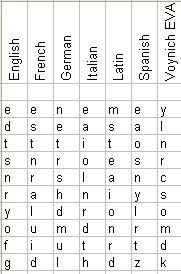

There are practically no words comprising more than ten glyphs, yet there are also few one- or two-letter words. On the other hand, the Voynich manuscript's "language" is quite unlike European languages in several aspects. In the herbal section, the first word on each page occurs only on that page and may possibly be the name of the plant.

There are very few repetitions among the thousand or so "labels" attached to the illustrations. Some words occur only in certain sections, or in only a few pages others occur throughout the manuscript. For instance, the word entropy (about 10 bits per word) is similar to that of English or Latin texts. Statistical analysis of the text reveals patterns similar to those of natural languages. These seem to follow phonological or orthographic laws of some sort, e.g., certain characters must appear in each word (like English vowels), some characters never follow others, some may be doubled or tripled but others may not, etc. Wider gaps divide the text into about 35,000 "words" of varying length.

Friedman in the 1940s, where each line of the manuscript was transcribed to an IBM punch card to make it machine-readable. The first major one was created by cryptographer William F. Various transcription alphabets have been created, to equate the Voynich glyphs with Latin characters in order to help with cryptanalysis, such as the European Voynich Alphabet. While there is some dispute as to whether certain glyphs are distinct or not, an alphabet with 20–30 glyphs would account for virtually all of the text the exceptions are a few dozen rarer characters that occur only once or twice each. Most of the glyphs are written with one or two simple pen strokes. The text consists of over 170,000 discrete glyphs, usually separated from each other by narrow gaps. However, such writing fluency could also be achieved by copying prepared coded text from some other source, such as a wax tablet or separate manuscript. Whoever the scribe was, he or she was practiced in writing the script.

The ductus flows smoothly, giving the impression that the symbols were not enciphered, as there is no delay between characters as would normally be expected in written encoded text. There is no obvious punctuation, and no indications of any errors or corrections made at any place in the document. Longer sections are broken into paragraphs, sometimes with star- or flower-like "bullets" in the left margin. The text was clearly written from left to right, with a slightly ragged right margin. TextĪ page showing characteristics of the text While most of them represent common motifs, the illustrations appear also to be unique to this manuscript. The manuscript is written in an elegant, but otherwise unknown script and almost all its pages contain illustrations of unkown plants, constellations or systems of tubes transporting liquids and populated by tiny, pudgy 'nymphs'.īased on modern analysis, it has been determined that a quill pen and iron gall ink were used for the text and figure outlines.Ĭolored paint was applied (somewhat crudely) to the figures, possibly at a later date. There is strong evidence that many of the book's bifolios were reordered at various points in its history, and that the original page order may well have been quite different from what we see today. From the various numbering gaps, it seems likely that in the past the manuscript had at least 272 pages, some of which were already missing when Wilfrid Voynich acquired the manuscript in 1912. The top righthand corner of each recto (righthand) page has been numbered from 1 to 116, probably by one of the manuscript's later owners. The manuscript has approximately 240 pages in total, depending on how some of its unusual fold-out multi-part pages are counted. Some annotations on the inside cover have been made by later owners. It has a limp vellum cover, added at a later date (probably the 17th century), without any indication of its origin (year, title or author). The manuscript is a parchment codex in octavo, measuring 23.5 by 16.2 by 5 centimeters (9.3 by 6.4 by 2.0 in), made of hundreds of vellum pages collected into eighteen quires.


 0 kommentar(er)
0 kommentar(er)
